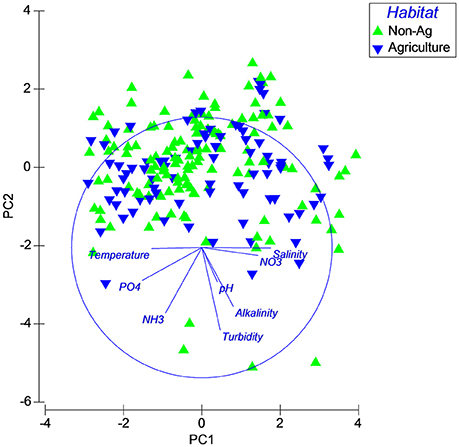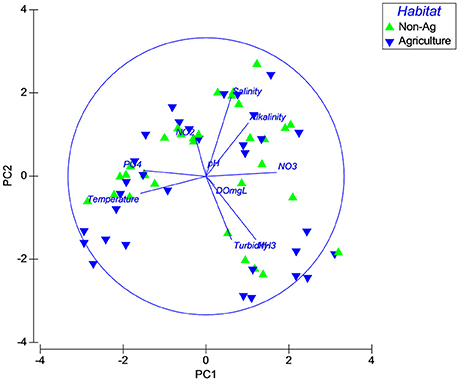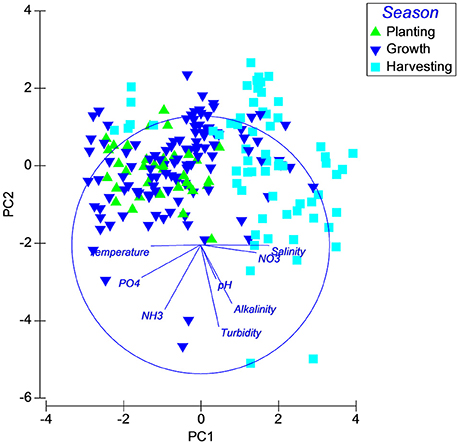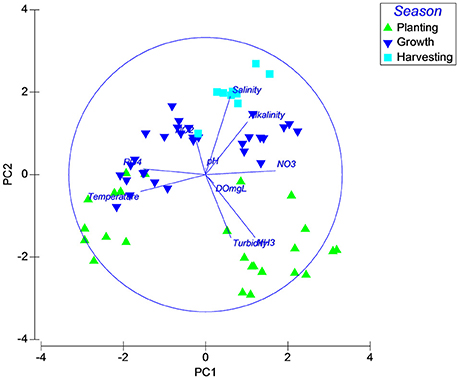Water Quality Analysis of Agriculturally Impacted Tidal Blackbird Creek, Delaware
- Department of Agriculture/Natural Resources, Delaware State University, Dover, DE, USA
Blackbird Creek, Delaware is a small watershed in northern Delaware that has a significant proportion of land designated for agricultural land use. The Blackbird Creek water monitoring program was initiated in 2012 to assess the condition of the watershed's habitats using multiple measures of water quality. Habitats were identified based on percent adjacent agricultural land use. Study sites varying from five to fourteen were sampled biweekly during April and November, 2012–2015. Data were analyzed using principal component analysis and generalized linear modeling. Results from these first 4 years of data documented no significant differences in water quality parameters (dissolved oxygen, pH, temperature, salinity, inorganic nitrate, nitrite, ammonia, orthophosphate, alkalinity, and turbidity) between the two habitats, although both orthophosphate and turbidity were elevated beyond EPA-recommended values. There were statistically significant differences for all of the parameters between agriculture seasons. The lack of notable differences between habitats suggests that, while the watershed is generally impacted by agricultural land use practices, there appears to be no impact on the surface water chemistry. Because there were no differences between habitats, it was concluded that seasonal differences were likely due to basic seasonal variation and were not a function of agricultural land use practices.
Introduction
Over half of the United States population resides along the coastal and estuarine areas (Crossett et al., 2004), threatening local ecosystems due to changing land use and causing changes in soil and groundwater chemistry, watershed-level hydrology, and dissolved nutrients in waterways, particularly in the form of nitrogen, and phosphorous species. As a whole, the United States has increased its use of commercial fertilizers from about 6.8 million metric tons in 1960 to roughly 20.0 million metric tons in 2011 in order to accommodate rapid population growth and need for increased food quantities, nearly a 3-fold increase (Nehrling, 2013). The coastal state of Delaware has grown slightly faster than the United States as a whole. Delaware grew 4.2% between 2010 and 2014 while the country grew about 3.3% (Index Mundi, 2014).
Water resources throughout the Mid-Atlantic coastline of the United States are facing constant and increasing threats from growing human population (Postel et al., 1996; Pimentel et al., 2004). Therefore, water resource management needs to be a priority as land use is modified to accommodate this population increase. The change from a native ecosystem to an agricultural landscape, for example, has far-reaching implications, including increased soil erosion, fertilizer runoff, removal of critical wildlife habitat, and loss of ecosystem services which help mitigate the effects of climate change (i.e., carbon sequestration; Schempf and Cox, 2007). Wetlands are aquatic ecosystems that provide a wide range of services such as maintenance of water quality, regulation of atmospheric gases, and protection of shorelines (Dise, 2009; Clarkson et al., 2013). It is becoming more apparent that wetland resilience is the key to predict how such an ecosystem will accommodate long-term issues such as climate change, sea level rise, and permanent change due to human use.
Understanding the quality of the water in any aquatic ecosystem is a critical first step to begin identifying characteristics of that ecosystem and draw conclusions about how well adapted the system is in terms of anthropogenic activity and climate change. Tidal creeks are critical aquatic nurseries for a wide variety of fish and crustaceans, which are susceptible to changes in water chemistry and quality (Greenwood et al., 2012). Our water quality assessment study is focused on Blackbird Creek, a fresh water tidal creek ecosystem which has a great potential for eutrophic conditions, with up to 36% of the basin comprised on agriculture land cover (DNREC, 2006). These lands are fertilized to accommodate the timely growth of crops (Lu et al., 2012). Nutrient loading can lead to eutrophication, a common problem for wetlands adjacent to agricultural lands that tends to favor the growth of aggressive, invasive, often weedy, plant species which displace native wetland plants. Given that such a large proportion of the watershed is likely fertilized on at least a semi-annual basis, it was hypothesized that the nutrient levels throughout the creek would be elevated, especially immediately after fertilization in early spring, referred to as the planting season, and following harvest in the fall (harvesting season).
Several studies have been published to establish links between water quality and land use practices (i.e., Holland et al., 2004; Huang et al., 2015) and between water quality and tidal creek hydrodynamics (Davis et al., 2012). However, such information is generally lacking along the Delaware coastal plain. The main goal in initiating this study was to determine the water quality in a large intertidal creek along the Delaware coastline in areas within direct adjacent cropland use and areas located in forested wetlands, and determine if certain parameters were within federal and state recommended levels. The specific objective of this study was to identify spatiotemporal variations in water chemistry and quality throughout a tidal stream in central Delaware. Periodic longitudinal sampling was performed in order to determine these characteristics. Results from this study provide a baseline for characterizing similar dynamic watersheds throughout the mid-Atlantic region, which had previously been given little attention in water quality assessments.
Materials and Methods
Study Area
Blackbird Creek is a tidal waterway located along the central Delaware that drains a watershed of about 80.29 km2 into the Delaware Bay (Figure 1). Roughly half of its 44.10 km in length is affected by tidal fluctuations while the upper portion of the waterway is comprised of freshwater only. Several sites were selected in the tidal portion of the creek, representative of the lower 8.05 km of the waterway nearest to the Delaware Bay. Within a 500 m × 500 m randomly generated gridded cell (ArcGIS), the percentage of agricultural land was calculated. Those sites with less than five percent agricultural land use were identified as “Non-Agriculture” (Non-Ag) sites while those with greater than five percent agricultural land use were identified as “Agriculture” (Ag) sites. This study was ever-expansive, covering six site locations in 2012–2014, and 14 in 2015 in order to maximize understanding of the system as a whole. In 2015, the general area where data were collected was adjusted from previous years. In 2012–2014, the stations were located generally within the lower 6.44 km of the watershed, whereas in 2015, the sampling locations were between 4.83 km and 14.48 km from the mouth of the creek (Figure 1).
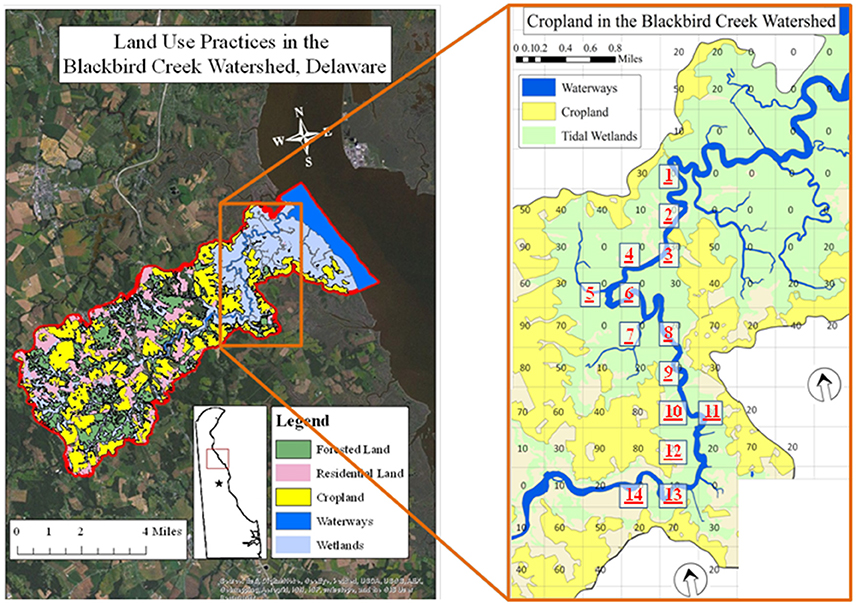
Figure 1. Land use practices (left) and site locations (right) for water quality measurements in Blackbird Creek, Delaware. Each site is 500 × 500 m. Sites labeled alphabetically in black identify those in which water quality measurements were taken in 2012–2014. Sites labeled numerically in red identify those in which measurements were taken in 2015.
Sample Collection and Analysis
Surface water was collected roughly every 14 days between the months of May and November, 2012–2015. From each site, water was collected into dark polyethylene bottles (rinsed three times with sample water), then placed on ice and transported to the lab for immediate nutrient analyses. For ex situ analyses, the samples were measured for nitrate, nitrite, ammonia, orthophosphate, turbidity, and alkalinity. Because orthophosphate is reactive in nature, a subsample of water was filtered on site into a separate bottle in order to minimize the potential for such reactions. Nitrate was determined using HACH Method No.8171, the cadmium reduction method to detect levels between 0.1 mg L−1 NO3 and 10.0 mg L−1 NO3. Nitrite concentration was evaluated using HACH Method No.8507, the diazotization method with detection levels up to 0.30 mg L−1. Ammonia was measured using the Ammonia salicylate method, HACH Method No.8155, detecting ammonia concentrations between 0.01 mg L−1 NH3 and 0.50 mg L−1 NH3. Orthophosphate concentrations were determined using HACH Method No.8048, the ascorbic acid method. This reaction provided information on soluble reactive phosphate concentrations between 0.02 mg L−1 and 2.50 mg L−1 . Each of these parameters was measured on a HACH DR 3900 spectrophotometer (HACH, Loveland, CO). Palintest kits were used to determine alkalinity and turbidity concentrations in Blackbird Creek and measured on a YSI 9500 Photometer (YSI Incorporated, Yellow Springs, OH). Alkalinity was evaluated using an automatic wavelength selection, measuring between 0 and 500 mg L−1 CaCO3. Turbidity was also determined with an automatic wavelength selection and presented in Formazin Turbidity Units (FTU). This method allowed for measurements between 5 FTU and 400 FTU. Physical data were collected in situ at the time of water collection. Temperature (°C), pH, salinity (ppt) via conductivity (mS cm−1), and dissolved oxygen (mg L−1) were measured with a YSI 556 multiprobe.
Statistical examination included multiple univariate generalized linear models (GLM) across years, agriculture seasons, and habitats (“Ag” or “Non-Ag”) and all interactive terms therein (SPSS 23 for Windows, IBM Corp., Armonk, NY) followed by principal component analysis (PCA) (PRIMER 6 version 6.1.16 - PRIMER-E, Plymouth, UK). The PCA was run between 2012 and 2014 to test across identical site locations, then in 2015 alone because the data were collected in a different general area within the watershed.
Results
The mean values of each of the water quality parameters are available in Table 1. Average turbidity and were greater than EPA-recommended values.

Table 1. Mean values for water quality parameters according to seasons and habitats with one standard error in parentheses.
Generalized Linear Models
The Generalized Linear Models (GLMs) showed that there were significant differences between habitats for NO3 [χ2 (2, 291) = 14.046; p = 0.001], salinity [χ2 (2, 302) = 369.761; p = 0.002], and DO [χ2 (2287) = 2230; p <0.001] (Table 2). Nitrate was greater in “Non-Ag” areas (0.27 mg L−1 ± 0.024 SD) than “Ag” areas (0.24 mg L−1 ± 0.023 SD). Salinity was greater at “Non-Ag” stations (6.00 ± 0.185 SD) than “Ag” stations (5.58 ± 0.227 SD). Dissolved oxygen was greater in “Non-Ag” areas (5.88 mg L−1 ± 0.101 SD) than in “Ag” areas (5.31 mg L−1 ± 0.147 SD). There were no differences between habitats for the remaining parameters.
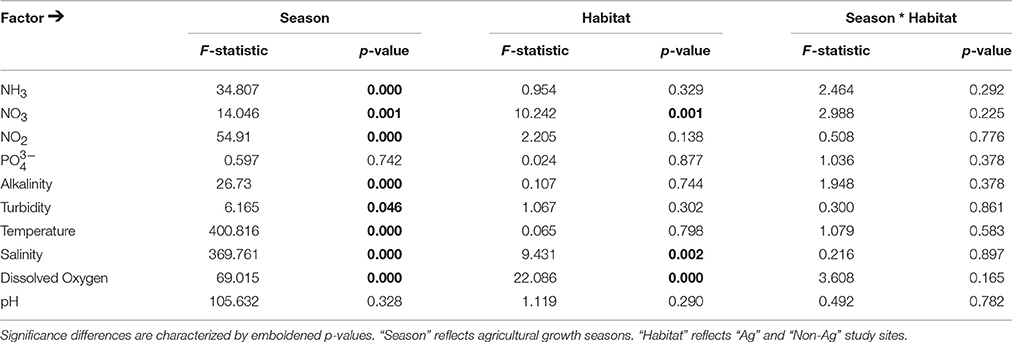
Table 2. Statistical output of generalized linear models with F-statistics and p-values for each dependent variable within each main effect and the interaction term.
Seasons were identified as they related to agricultural seasonal variation was evident for many of the water quality parameters. The GLM analysis reported significant differences between seasons for every variable studied with the exception of and pH (Table 2). These results were largely confirmed with the Analysis of Variance (ANOVA), with the exception of . Analysis of variance showed that the concentration of in the harvesting season was significantly lower than the planting or growth seasons [F (2, 331) = 4.743; p = 0.009]. Post-hoc Tukey tests revealed that ammonia, alkalinity, temperature, and salinity differed between all seasons. Ammonia concentration was greatest in the planting season (0.14 mg L−1 ± 0.006 SD) and lowest in the harvesting season (0.09 mg L−1 ± 0.004 SD). Alkalinity was greatest during the harvesting season (92.02 mg CaCO3 L−1 ± 1.766 SD) and lowest in the planting season (77.92 mg CaCO3 L−1 ± 2.133 SD). Surface water temperature was, as expected, highest during the growth season, which coincided with mid-summer (26.48°C ± 0.108 SD) and lowest in the harvesting season, which stretched into November (19.54°C ± 0.397 SD). Salinity increased throughout the sampling season, with low values in the planting season (3.55 ± 0.111 SD) and high values in the harvesting season (8.41 ± 0.197 SD). The Tukey test also showed that there were no differences in the concentrations of NO3 between the planting and growth seasons, but concentrations increased significantly into the harvesting season. Nitrite concentration was not significantly different between the planting and harvesting seasons (p = 0.406), but there was a significantly greater concentration of nitrite in the growth season (p = 0.002). There was no difference between the growth and harvesting season for turbidity, but both of these seasons had lower turbidity values than those in the planting season. There were no statistically significant differences in DO between the planting (6.38 mg L−1 ± 0.157 SD) and harvesting seasons (5.85 mg L−1 ± 0.200 SD) (p = 0.051), but the concentration of DO was significantly lower in the growth season (5.14 mg L−1 ± 0.095 SD) (p = 0.001). None of the parameters studied were significant in the interaction term of season * habitat (Table 2).
Principal Component Analysis
Principal Component analysis (PCA) is a multivariate analysis method that was used to identify the environmental variables that can significantly impact the water quality at the study habitats seasonally. Our results display similarities in the water qualities of the study habitats, which suggest that there were no differences in the environmental variables at these habitats (Figures 2, 3).
The PCA also confirmed seasonal differences for many of the water quality parameters. For the study years 2012–2014, there was no difference among the growth and planting season whereas the water quality of the samples were comparatively different during the harvesting season. Salinity (0.53) and NO3 (0.46) were high among all the variables studied especially in the harvesting season. Temperature was high in the planting and growth season while most of the other variables seem to be low in the samples. There is a clear distinction among the samples with respect to the sampling years. In 2015, alkalinity, salinity, NO2 and NO3 were elevated in the growth season, while turbidity was elevated in the planting season. A clear difference can be seen between the seasons for turbidity and NH3, which were high during the planting season (Figures 4, 5).
Discussion and Conclusion
This study showed that water quality in Blackbird Creek is consistent throughout the watershed. Most of the parameters followed predictable seasonal patterns. Temperature and salinity increased and decreased as expected between seasons, but there were no differences in these parameters between habitats. Tidal direction likely influenced salinity as high saline water enters the creek from the Delaware Bay on incoming tides, whereas fresher water from upstream springs reduce salinity on outgoing tides, particularly at the end of the tidal regimes.
Turbidity throughout the waterway was quite high, with maximum values well over 100 Formazin Turbidity Units (FTU) for three of the four sampling years. This parameter does not meet the EPA and DNREC standards for regulation of 10 FTU (USEPA, 1998), and studies have shown that such high values can be detrimental to the ecosystem. For example, high turbidity can limit the opportunity for fish that rely on sight to find prey and often will leave the system in order to find a more suitable location to search for a food source (Kirk, 1994; De Robertis et al., 2003). Also, high turbidity can reduce light penetration into the water to the point that submerged aquatic vegetation (SAV) and phytoplankton cannot photosynthesize for lack of light energy. The Upper Mississippi River Conservation Committee (UMRCC), for example, recommended turbidity values of 20 NTU or lower in order to sustain SAV production. Blackbird Creek does not have any SAV in the creek where samples were taken (UMRCC, 2003). It is not unlikely that the high turbidity explains this. The lack of SAV could be having detrimental effects in the creek, including lack of photosynthesis to provide dissolved oxygen to the water, and lack of hiding places for prey species to avoid predators. These high values are probably a function of the nature of the tidal creek rather than any deleterious effect from human use of land along the watershed. The hydrodynamics of tidal systems are extremely complex and difficult to model because of the rheological behavior of the soft mud within which can dissociate under varying conditions (Dyer et al., 2004; Uncles et al., 2006).
Because high turbidity reduces light penetration and influences the amount of SAV, there is a link between turbidity and dissolved oxygen. Generally, the dissolved oxygen in the creek was at appropriate levels according to the minimum acceptable standard of 5.0 mg L−1 outlined by the Delaware Natural Resources and Environmental Control (DNREC, 2006) and the 4.8 mg L−1 designated by the Environmental Protection Agency (USEPA, 2000). Indeed, this was the only parameter where there was any spatial difference, and there were instances where DO was too low to be able to sustain respiring biota. Most of these values, it is believed, were transient and a function of the tide. If the tide was slack, there was little opportunity for direct injection of oxygen from the air-water interface via wave action (Bascheck et al., 2006). Tidal amplitude, however, was not measured in this study and will be accommodated in subsequent research.
Blackbird Creek did have elevated levels of soluble reactive phosphate according to Boyd and Tucker (1998), where the maximum concentration should not exceed 0.05 mg L−1. The average concentration in this system was 0.54 mg L−1. While there may not have been any significant differences between sites or across time, this was alarming. Such high values can have detrimental effects on local biota (Schindler, 1974, 1977; Havens, 2008). Because this is a water quality investigation of a single watershed with no comparative opportunity, only speculations are afforded to explain the high soluble reactive phosphate. The values could be attributable to two sources: natural erosion of the creek bed and channel sides due to fluctuating tides, or land modification by anthropogenic activity and the spraying of phosphate-laden fertilizers onto the land surface which then runoff into the waterway. Data are not available that show what specific crops were used or what specific fertilizers were used in the watershed throughout the study period. This information will be garnered for subsequent research.
There is a riparian buffer system of trees and marsh grasses throughout the creek. In fact, only one 500 m long strip of the creek does not have any sort of buffer (about 1.2% of the total length of the main branch of the waterway). Therefore, it seems unlikely that land runoff would be solely responsible for elevated soluble reactive phosphates (Mayer et al., 2007). It is more probable that the high levels are a function of the natural fluctuation of the tides. Phosphorous can enter the system by weathering of soils and minerals. As the water enters and exits the creek, it scours along the stream banks, eroding it and increasing the turbidity and suspended solids onto which phosphates could adsorb.
Generally, Blackbird Creek is a typical semi-pristine tidal waterway. There is little urban use in the watershed, but considerable designation for agriculture. There were low values of nitrate, nitrite, and ammonia, and appropriate seasonal changes in the physical parameters. The only concerns in this system were extremely high turbidity and elevated soluble reactive phosphates. These both may have been a part of the natural system, but it is possible that human influence may have been, at least in part, the cause of such levels. Additional research will be necessary to be able to answer these questions with greater certainty.
Author Contributions
MS, KR, and LP were responsible for sample collection and processing. MS and LC performed statistical analyses. MS was primary author with some assistance from LC, VK, and GO. GO and VK were project directors and will be responsible for stewardship of the research following publication. GO is the corresponding author.
Funding
This study was supported primarily by the NSF EPSCoR Program Grant Award# EPS-1301765, and partially by USDA-NIFA CBG Grant Award# 2014-38821-22430 and USDA-NIFA CBG Grant Award# 2013-38821-21246.
Conflict of Interest Statement
The authors declare that the research was conducted in the absence of any commercial or financial relationships that could be construed as a potential conflict of interest.
References
Bascheck, B., Farmer, D. M., and Garrett, C. (2006). Tidal fronts and their role in air-sea exchange. J. Mar. Res. 64, 483–515. doi: 10.1357/002224006778715766
Boyd, C. E., and Tucker, C. S. (1998). Pond Aquaculture Water Quality Management. Nowell, MA: Kluwer Academic Publishers.
Clarkson, B. R., Ausseil, A.-G. E., and Gerbeaux, P. (2013). “Wetland ecosystem services,” in Ecosystem Services in New Zealand–Conditions and Trends. eds J. R. Dymond (Lincoln: Manaaki Whenua Press), 192–202.
Crossett, K., Culliton, T. J., Wiley, P., and Goodspeed, T. R. (2004). Population Trends Along the Coastal United States, 1980–2008. Report: National Oceanic and Atmospheric Administration. Silver Spring. 47.
Davis, A. P., Stagge, J. H., Jamil, E., and Kim, H. (2012). Hydraulic performance of grass swales for managing highway runoff. J. Water Res. 46, 6775–6786. doi: 10.1016/j.watres.2011.10.017
De Robertis, A., Ryer, C. H., Veloza, A., and Brodeur, R. D. (2003). Differential effects of turbidity on prey consumption of piscivorous and planktiverous fish. Can. J. Fish. Aquat. Sci. 60, 1517–1526. doi: 10.1139/f03-123
Dise, N. B. (2009). Peatland Response to Global Change. Science 326, 810–811. doi: 10.1126/science.1174268
Dyer, K. R., Christie, M. C., and Manning, A. J. (2004). The effects of suspended sediment on turbulence within an estuarine turbidity maximum. Est. Coast. Shelf Sci. 59, 237–248. doi: 10.1016/j.ecss.2003.09.002
Greenwood, M. J., Harding, J., Niyogi, D. K., and McIntosh, A. R. (2012). Improving the effectiveness of riparian management for aquatic invertebrates in a degraded agricultural landscape: stream size and land-use legacies. J. Appl. Ecol. 49, 213–222. doi: 10.1111/j.1365-2664.2011.02092.x
Havens, K. E. (2008). Cyanobacteria blooms: effects on aquatic ecosystems. Adv. Exp. Med. Biol. 619, 733–747. doi: 10.1007/978-0-387-75865-7_33
Holland, A. F., Sanger, D. M., Gawle, C. P., Lerberg, S. B., Santiago, M. S., Riekerk, G. H. M., et al. (2004). Linkages between tidal creek ecosystems and the landscape and demographic attributes of their watersheds. J. Exp. Mar. Biol. Ecol. 298, 151–178. doi: 10.1016/S0022-0981(03)00357-5
Huang, C., Jiang, M., Zou, J., Zhu, A., Chen, X., Mi, Y., et al. (2015). Changes in land use, climate, nd the environment in a period of rapid economic development in Jiangsu Province, China. Sci. Total Environ. 536, 173–181. doi: 10.1016/j.scitotenv.2015.07.014
Index Mundi (2014). United States - Population Growth Rate (2010 - 2014) by State. Available online at: http://www.indexmundi.com/facts/united-states/quick-facts/all-states/population-growth#map
Kirk, J. T. O. (1994). Light and Photosynthesis in Aquatic Ecosystems, 2nd Edn. Cambridge; New York, NY: University Press.
Lu, Q., He, Z. L., and Stoffella, P. J. (2012). Land application of biosolids in the USA: A Review. Appl. Envrion. Soil Sci. 2012:201462. doi: 10.1155/2012/201462
Mayer, P. M., Reynolds, S. K. Jr., McCutchen, M. D., and Canfield, T. J. (2007). Meta-analysis of nitrogen removal in riparian buffers. J. Environ. Qual. 36, 1172–1180. doi: 10.2134/jeq2006.0462
Nehrling R. (2013). Fertilizer Use and Markets: USDA Website. Available online at: http://www.ers.usda.gov/topics/farm-practices-management/chemical-inputs/fertilizer-use-markets.aspx
Pimentel, D., Berger, B., Filiberto, D., Newton, M., Wolfe, B., Karabinakis, E., et al. (2004). Water Resources, Agriculture, and the Environment. Ithaca, NY: New York State College of Agriculture and Life Sciences, Cornell University. Report 04–1.
Postel, S. L., Daily, G. C., and Ehrlich, P. R. (1996). Human appropriation of renewable fresh water. Science 271, 785–787. doi: 10.1126/science.271.5250.785
Schempf, M., and Cox, C. A. (2007). Managing Environmental landscapes for environmental quality: strengthening the science base. Soil and water conservation society: ankeny, IA. Dise, N.B. 2009. Peatland response to global change. Science 326, 810–811. doi: 10.1007/978-1-4615-5407-3
Schindler, D. W. (1974). Eutrophication and recovery in experimental lakes: implications for lake management. Science 184, 897–899. doi: 10.1126/science.184.4139.897
Schindler, D. W. (1977). The evolution of phosphorous limitation in lakes. Science 195, 260–262. doi: 10.1126/science.195.4275.260
UMRCC (2003). Proposed Light-Related Water Quality Criteria Necessary to Sustain Submersed Aquatic Vegetation in the Upper Mississippi River. Upper Mississippi River Conservation Committee. Water Quality Technical Section.
Uncles, R. J., Stephens, J. A., and Law, D. J. (2006). Turbidity maximum in the macrotidal, highly turbid Humber Estuary, UK: flocs, fluid mud, stationary suspensions and tidal bores. Est. Coast. Shelf Sci. 67, 30–52. doi: 10.1016/j.ecss.2005.10.013
Keywords: water quality, mid-atlantic region, tidal creek, agriculture, runoff, soil conservation, management
Citation: Stone ML, Roeske K, Chintapenta LK, Phalen L, Kalavacharla V and Ozbay G (2016) Water Quality Analysis of Agriculturally Impacted Tidal Blackbird Creek, Delaware. Front. Environ. Sci. 4:70. doi: 10.3389/fenvs.2016.00070
Received: 21 July 2016; Accepted: 14 October 2016;
Published: 02 November 2016.
Edited by:
Khwaja M. Sultanul Aziz, Bangladesh Academy of Sciences, BangladeshReviewed by:
Muhammed Zeaur Rahim, International Centre for Diarrhoeal Disease Research, BangladeshMaria Ines Zanoli Sato, CETESB - Environmental Company of the São Paulo, Brazil
Copyright © 2016 Stone, Roeske, Chintapenta, Phalen, Kalavacharla and Ozbay. This is an open-access article distributed under the terms of the Creative Commons Attribution License (CC BY). The use, distribution or reproduction in other forums is permitted, provided the original author(s) or licensor are credited and that the original publication in this journal is cited, in accordance with accepted academic practice. No use, distribution or reproduction is permitted which does not comply with these terms.
*Correspondence: Gulnihal Ozbay, gozbay@desu.edu
 Matthew L. Stone
Matthew L. Stone  Kristopher Roeske
Kristopher Roeske Lathadevi K. Chintapenta
Lathadevi K. Chintapenta Laurieann Phalen
Laurieann Phalen Venugopal Kalavacharla
Venugopal Kalavacharla Gulnihal Ozbay
Gulnihal Ozbay